Foods you have to eat in France – France, renowned for its rich cultural heritage, picturesque landscapes, and perhaps most notably, its exquisite cuisine, stands as a culinary mecca enticing food enthusiasts from around the globe. French gastronomy is more than just sustenance; it’s a deeply ingrained aspect of the country’s identity, reflecting centuries of tradition, innovation, and regional diversity. From the bustling markets of Paris to the quaint villages of Provence, the essence of French cuisine permeates every corner of the nation, inviting visitors on a delectable journey of taste and discovery.
In this exploration of “Foods you have to eat in France,” we delve into the quintessential dishes and delicacies that define French culinary excellence. Each bite tells a story of culinary mastery, heritage, and passion, offering a sensory experience that transcends mere nourishment. Join us as we embark on a tantalizing adventure through the flavors of France, where every meal is a celebration of artistry and culture, leaving an indelible imprint on the palates and memories of those fortunate enough to partake..
Table of Contents
ToggleFoods you have to eat in France
Croissant:

A croissant is a staple of French breakfast cuisine, beloved for its flaky layers and buttery taste. Originating from Vienna, Austria, it was perfected in France, where it became an iconic pastry. The traditional croissant is made from a laminated dough consisting of butter, flour, sugar, salt, and yeast, rolled and folded multiple times to create its distinct layers. Whether enjoyed plain or filled with chocolate, almond paste, or ham and cheese, a freshly baked croissant pairs perfectly with a cup of coffee or tea, making it a delightful morning treat enjoyed by locals and visitors alike.
Also, Read – Must-Try Dishes To Get in New Orleans
Baguette:

The baguette is perhaps the most iconic symbol of French bread. With its long, thin shape and crispy crust, it’s a staple in French bakeries and households. Traditionally made from just four simple ingredients—flour, water, salt, and yeast—the baguette is known for its airy interior and chewy texture. It’s typically enjoyed fresh from the oven, either as a side to a meal, as a base for sandwiches (such as the classic jambon-beurre), or simply with butter or cheese. The baguette is deeply ingrained in French culture, with strict regulations governing its production to ensure quality and authenticity.
Foie Gras:
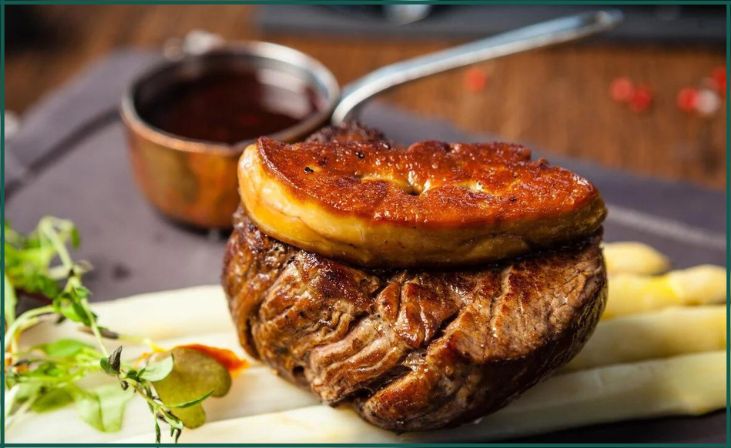
Foie gras, meaning “fat liver” in French, is a delicacy made from the fattened liver of ducks or geese. It has a rich, buttery flavor and a silky texture that melts in your mouth. The process of producing foie gras involves force-feeding the birds to enlarge their livers, a practice that has sparked controversy among animal welfare activists. Despite this, foie gras remains a prized ingredient in French cuisine, often served as a pâté alongside toasted bread or as a component of elegant dishes in upscale restaurants. Its decadent taste and luxurious reputation make it a must-try for culinary enthusiasts seeking an indulgent experience.
Coq au Vin:
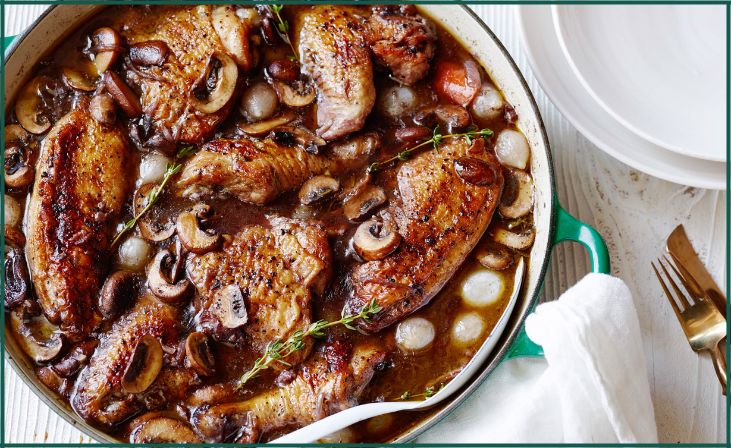
Coq au Vin is a classic French dish that showcases the country’s culinary prowess. Translating to “rooster in wine,” it traditionally featured an old rooster slow-cooked in red wine to tenderize the meat. Today, chicken is more commonly used due to its widespread availability. The dish also includes mushrooms, onions, bacon, and aromatic herbs, all simmered together to create a rich and flavorful stew. Coq au Vin is a comforting meal often served during special occasions or enjoyed as a hearty family dinner. Its complex flavors and rustic charm exemplify the rustic yet refined nature of French cuisine.
Don't just scroll, subscribe!
BuzzTrail's unique web-stories are the cure for boredom you've been waiting for.
Also, Read – Easy Soups That Are Ready Within an Hour
Bouillabaisse:
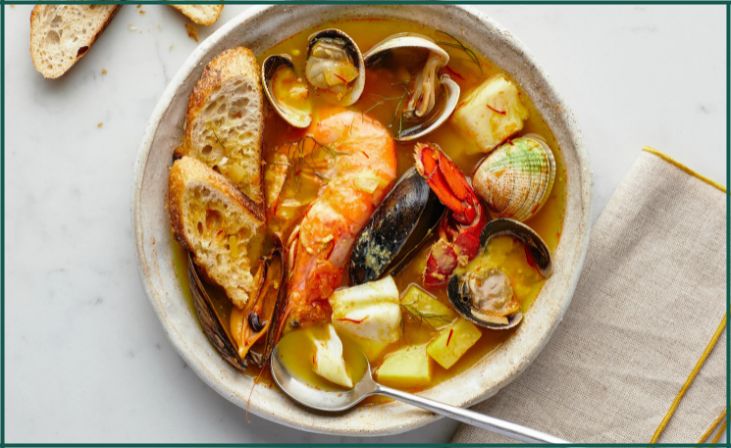
Bouillabaisse is a traditional Provençal fish stew originating from the port city of Marseille. It is characterized by its rich saffron-infused broth and a variety of seafood, which can include fish such as sea bass, monkfish, and mullet, as well as shellfish like mussels, clams, and shrimp. The stew is typically served with slices of crusty bread and a rouille, a garlicky saffron-infused mayonnaise, on the side. Bouillabaisse is a celebration of the Mediterranean’s bounty, with each spoonful offering a taste of the sea. It is often enjoyed as a communal meal shared with family and friends, accompanied by a glass of chilled white wine.
Escargots:
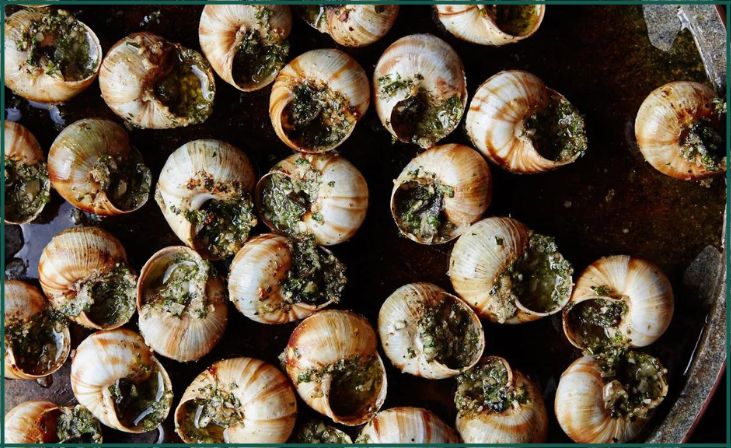
Escargots, or snails, have been a part of French cuisine since ancient times, enjoyed for their unique flavor and texture. Typically served as an appetizer, they are cooked in a garlic butter sauce and served in their shells, often accompanied by crusty bread for dipping. The tender, succulent snails absorb the flavors of the butter and garlic, creating a dish that is both savory and indulgent. While the thought of eating snails may be daunting to some, escargots are a beloved delicacy in France, enjoyed in both casual bistros and upscale restaurants alike. Trying escargots is not only a culinary adventure but also an opportunity to embrace the rich gastronomic heritage of France.
Cassoulet:
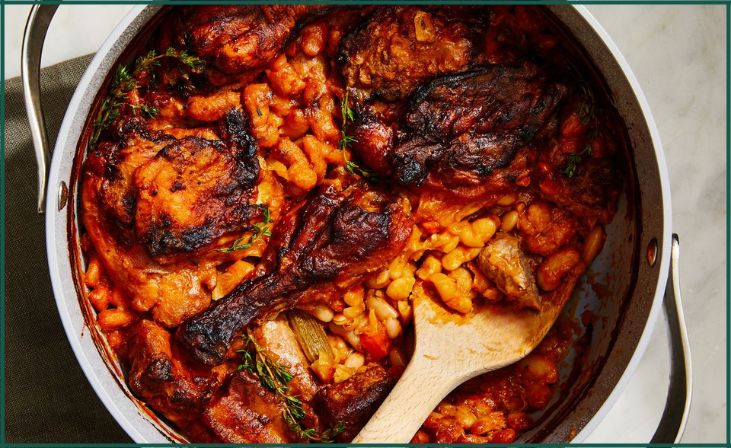
Cassoulet is a hearty and comforting French stew originating from the region of Languedoc. It is made with white beans, which are simmered with various meats such as duck confit, pork sausages, and sometimes lamb, along with aromatic vegetables like onions, carrots, and garlic. The dish is slow-cooked for several hours, allowing the flavors to meld together and creating a thick, hearty stew. Cassoulet is often served as a main course during cold winter months, accompanied by crusty bread and a robust red wine. Its rustic simplicity and robust flavors make it a beloved comfort food in France, perfect for warming both body and soul.
Crème Brûlée:
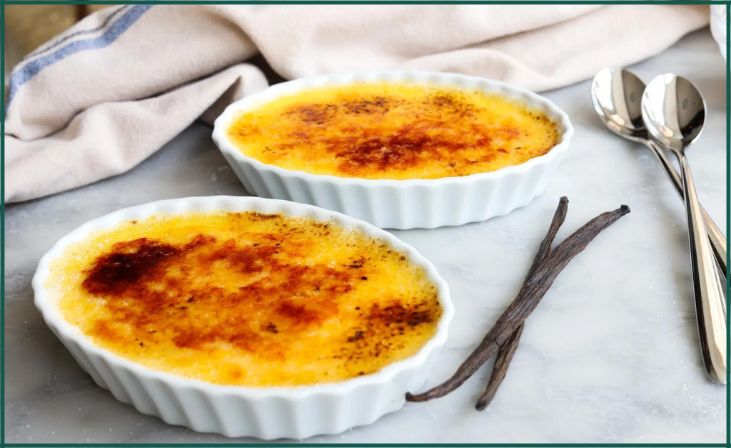
Crème Brûlée, meaning “burnt cream” in French, is a classic dessert known for its creamy custard base and crisp caramelized sugar topping. To make crème brûlée, a rich custard made from egg yolks, cream, sugar, and vanilla is baked until set, then chilled until firm. Just before serving, the custard is sprinkled with a layer of sugar, which is then caramelized using a culinary torch or broiler until it forms a golden-brown crust. The result is a delightful contrast of textures, with the smooth, cool custard beneath the crackling layer of caramelized sugar. Crème Brûlée is a beloved dessert in France, often served in elegant restaurants and bistros as a sweet finale to a memorable meal. Its simple yet sophisticated presentation makes it a timeless classic that never fails to impress.
Conclusion
In conclusion, French cuisine captivates not only the palate but also the soul, embodying a rich tapestry of tradition, innovation, and gastronomic delight. From the buttery croissants of breakfast to the savory indulgence of coq au vin and the delicate sweetness of macarons, each dish tells a story of culinary artistry and cultural heritage. Whether sipping wine in Bordeaux, savoring cheese in Normandy, or indulging in street-side crêpes in Paris, the flavors of France leave an unforgettable impression. So, let us continue to savor and celebrate the exquisite tastes of France, for they are an eternal feast for the senses.
FAQs
What is the quintessential French breakfast?
What is the quintessential French breakfast?
A quintessential French breakfast often includes a buttery croissant or pain au chocolat, accompanied by a cup of coffee or café au lait.
What is the significance of escargots in French cuisine?
What is the significance of escargots in French cuisine?
Escargots, or snails, hold cultural significance in French cuisine, often served as a delicacy. They are typically cooked with garlic butter and parsley, showcasing French culinary finesse.

